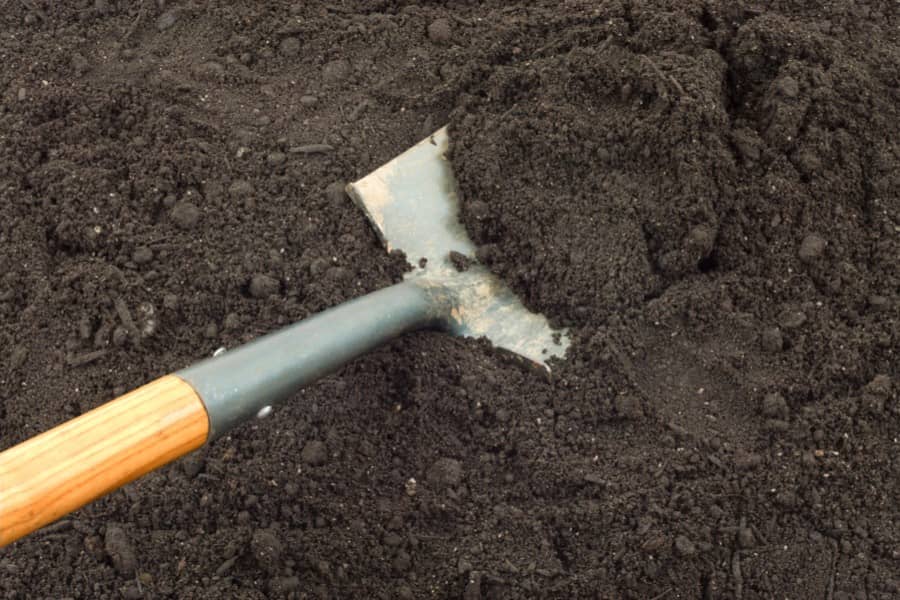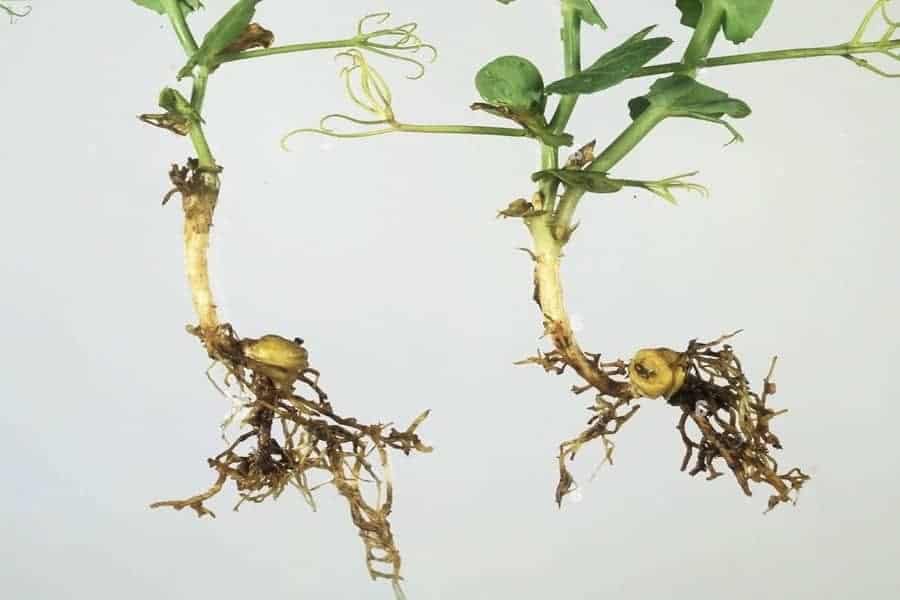
Nematodes are microscopic, eel-like plant parasites. Some of them are beneficial and others harmful. Root-feeding nematodes are by far the most troublesome species of all. They feed on plant roots and make it harder to intake water and nutrients, often resulting in wilted or stunted growth of the crops.
The proven techniques to get rid of harmful nematodes involve soil solarization, crop rotation, fallowing, growing nematode-repellent varieties, and adding organic soil amendments to the infested areas.
For optimal results, you must combine these practices with various cultural and management techniques we have shared below. To know more about nematodes in detail and how to kill them in the most effective yet easy manner, continue reading the article.
Dealing With Nematodes in Home Gardens
Root feeding nematodes, such as root-knot, cause the most harm to the gardens. They often attack vegetables, fruit trees, and ornamental plants. Such plant-feeding pests are difficult to control as they easily transmit from garden to garden via infested soil, plants, and tools.
Root-knot nematodes can survive from season to season as eggs in the soil. They go through 6 stages – an egg stage, four immature stages, and an adult stage.
During the summer months, nematodes grow fast – most species can go from an egg to an egg-laying adult in less than 21-28 days. By the time root-feeding nematodes reach second-stage juveniles, they start invading plant roots.
As of now, there are no chemical pesticides or soil fumigants available to home gardeners for dealing with nematodes. The only way to control these plant parasites is by making garden soil inhospitable for them.
How Nematodes Destroy Plants?
Root-feeding nematodes, as the name implies, feed and develop within plant roots. They damage crops by causing their root cells to enlarge, resulting in swelling, known as knots or galls. The formation of these galls tends to weaken the water and nutrient conducting abilities of the roots.
Root galls, when broken, will make plants more susceptible to soil-borne, disease-causing microorganisms. It can give rise to severe galling that will eventually kill the plant.
Detecting Nematodes Infestations
Root-knot nematodes are thread-like, microscopic worms that cannot be seen with naked eyes. Examining plants for the galled roots is the surest way to determine the presence of harmful nematodes in the soil.
Nematode-affected plants may also show aboveground symptoms such as wilting, yellow leaves, and other similar conditions that arises from lack of water and nutrition. Infested crops often have distorted growth and produce fewer and smaller leaves and fruits.
As we know, there are many species of plant-feeding nematodes. To confirm which one has infested your garden, collect soil and root samples and send them to a local laboratory for conducting a test.
Damage Causing Nematode Species
Apart from root-knot nematode, the following are the species that cause the most problem to home gardens and landscape plants:
- Ring nematode (Criconemoides xenoplax)
- Root lesion nematodes (Pratylenchus species)
- Sugarbeet cyst nematode (Heterodera schachtii)
- Citrus nematode (Tylenchulus semipenetrans)
- Stem and bulb nematode (Ditylenchus dipsaci)
How To Get Rid of Nematodes From Garden Soil?

Since there are no commercially available nematicides, we tend to resort to the different gardening methods to eliminate nematodes from our gardens. Following are some of the widely used, often old practices that work effectively against these garden pests.
#Method-1: Soil Solarization
Solarization is a highly efficient farming technique for controlling nematodes. Although solarizing is less effective in the long term, it’s a great way to temporarily reduce nematode populations in gardens.
This method involves the utilization of the Sun heat to raise the temperature of the soil to kill nematodes. Its effectiveness depends on the sunlight intensity or how deep the heat penetrates the soil. During summer, when Sun is at its highest, performing soil solarization will yield optimal results.
However, this will not make your soil completely nematode-free. Solarization only helps in wiping out the troublesome pests from the top few inches of the soil. It benefits shallow-rooted annual crops and allows the young woody plants to become established before nematodes attack.
How to kill nematodes with soil solarization:
The first step is to till the soil 6–8 inches deep. This process of turning over and breaking up clumps allows the heat from the sun to penetrate deeper into the ground. It will bring the nematode’s eggs to the surface, exposing them to intense sunlight.
Next, spray the overturned area. You have to moisten the soil but not wet it. This will drastically increase the heat of the solarized soil, effectively killing more nematodes.
After that, cover the soil using a clear polyethylene mulch or tarp. Stretch the sheet over the garden area and seal its edges by putting excess dirt around the corners. This will prevent it from blowing or tearing by the wind.
For effective solarization, leave the tarp in place for at least six weeks. Root-knot nematodes are usually killed when soil temperature exceeds 125°F for 30 minutes or 130°F for 5 minutes.
NOTE: after solarization, do not re-till your garden as it may bring nematodes from the deeper soil layers to the surface.
#Method-2: Crop Rotation
Crop rotation is yet another effective strategy to control harmful nematodes. It refers to the practice of not growing a susceptible host in the same site for more than one year.
Instead of entirely removing the nematode-susceptible plants from your garden, if you have space, plant them a few rows above before they were previously grown and sustained damage.
To increase the effectiveness of crop rotation, plant nematode-resistant varieties in infested sections of your garden. It can be done in alternate growing seasons. Seemingly, relocating susceptible vegetables to a row formerly planted with nematode repellent plants reduces the risk of severe damage.
Popular annual crops used for reducing nematodes include the following hosts:
- Small grains – wheat, rye, and barley
- Grass species – sudangrass, fescue
- Flowers – marigolds (Nemagold, Petite Blanc, Queen Sophia, and Tangerine and Tagetes species)
- Veggies – resistant tomato species such as cherry tomatoes and certain bean varieties.
If your garden is heavily affected by root-knot nematodes, perform plant rotation combined with fallowing and solarization.
Fallowing is a well-known farming technique where we leave the soil without sowing for one or more vegetative cycles. Leaving the soil bare for some time effectively reduce nematodes by killing them off with no food. The number of fallow years is the main factor determining the pest population you can eliminate.
#Method-3: Soil Amendments
Adding organic soil amendments to a garden not only improves the physiological condition of plants but helps reduce the damage caused by harmful pests.
As we know, root-feeding nematodes cause swelling in the root system, drastically reducing the plant’s ability to absorb and transport water and nutrients to the rest of the plant.
Therefore, by adding amendments including peat, manure, and compost, we can increase the soil’s water and nutrient holding capacity, as a result lessening the damage caused by nematodes.
Particularly, water-stressed plants are highly susceptible to these microscopic parasites. So frequent irrigation can be helpful in this case.
Best Practices For Controlling Root-Knot Nematodes
As you may already know, currently, there are no chemical nematicides or soil fumigants available for home gardeners. We primarily depend on various farming techniques, mainly preventive measures for controlling the root-feeding microscopic roundworms.
Preventing the infestation from spreading is probably the most crucial when dealing with nematodes. Following are the reliable practices to ensure nematodes don’t infect other sections or plants in your garden.
- Nematodes are easily spread via infested soil or plants. Therefore, avoid moving plants and soil from the affected parts of the garden to new areas.
- When buying new plants for your garden, ensure they are nematode-free by firmly inquiring with nursery owner.
- Irrigation water from around infested plants may also act as a potential carrier to nematodes, so make sure there is no runoff occurring.
- Nematodes are too small to be seen with naked eyes and can attach to tools when used in the infested areas. Washing the equipment thoroughly before using them elsewhere will reduce the risk of spread.
- Root-knot nematodes are comparatively less active in low soil temperatures (60°F). Therefore, adjusting planting dates to cooler months of the growing seasons will significantly reduce the risk of nematodes attack.
- Frequent irrigation and organic soil amendments make plants more tolerant to nematode injury.
- During fallowing, keep the soil moist for as long as possible. It will provide an ideal ground for the nematode eggs to hatch and die eventually due to no food availability.
- Using composted manure and urea as soil amendments helps increase the population of free-living beneficial nematodes. They are useful for suppressing parasitic nematodes.
- After harvest, till the soil and remove the roots of the nematode-affected plants.
Common Garden Plants and Their Nematode Pests
There are certain landscape plants, vegetables, and fruits that are more susceptible to plant-parasitic nematodes than others. The data for the following tables mainly applies to California and nearby states.
Landscape plants:
| Host Plant | Nematode(s) |
| albezia | root-knot |
| alder | root-knot |
| azalea | stunt |
| boxwood | root-knot |
| cactus | root-knot, cyst |
| catalpa | root-knot |
| cedar | root-knot, pinewood |
| euonymus | root-knot |
| fir | dagger |
| ginkgo | root-knot |
| hibiscus | root-knot |
| hydrangea | root-knot |
| juniper | root-knot |
| larch | pinewood |
| lilac | citrus |
| mulberry | root-knot |
| oak | root-knot |
| palm | root-knot |
| pine | pinewood |
| pittosporum | root-knot |
| poinsettia | root-knot |
| rose | root-knot, root lesion |
| spruce | pinewood |
| tamarisk | root-knot |
Fruits and Nuts:
| Host Plant | Nematode(s) |
| grape | root-knot, root lesion, ring, citrus, dagger, stubby root |
| blackberry, raspberry | root lesion, dagger |
| strawberry | root-knot, root lesion, foliar |
| almond | root-knot, root lesion, ring |
| apple | root-knot, root lesion |
| apricot | root-knot, root lesion, ring |
| avocado | root-lesion |
| cherry | root-lesion |
| citrus | root-lesion, citrus |
| olive | root-lesion, citrus |
| peach, nectarine | root-knot, root lesion, ring |
| pear | root-lesion |
| plum, prune | root-lesion, ring, pin |
| walnut | root-knot, root lesion |
Vegetables:
| Host Plant | Nematode (s) |
| beans | root-knot, root lesion |
| beets | root-knot, cyst |
| carrots | root-knot |
| celery | root-knot |
| cole crops | root-knot, cyst |
| corn | root-lesion |
| cucumbers | root-knot |
| eggplant | root-knot |
| garlic | stem and bulb |
| lettuce | root-knot |
| melons | root-knot |
| onions | stem and bulb |
| peas | root knot, root lesion, cyst |
| peppers | root-knot |
| potatoes (Irish) | root knot, root lesion |
| potatoes (sweet) | root-knot |
| radish | root-knot, cyst |
| spinach | root-knot, cyst |
| squash | root-knot |
| tomatoes | root-knot |
| turnips | root-knot, cyst |
Frequently Asked Questions
Q. What is the most effective way to get rid of nematodes?
Integrating two or more methods shared above will have a more significant impact. The combined use of plant rotation, resistance varieties, and management practices should significantly reduce the nematode damage.
Using these tactics continuously for a period of time will help bring the pests population down to a level where they aren’t a threat to your garden plants anymore.
Q. Will Epsom salt kill nematodes?
Epsom salt is a well-known agent for pest control in gardens. However, it’s not effective against nematodes.
Q. How effective is vinegar for nematodes?
Vinegar is widely used as a homemade worm killer. But when it comes to nematodes, especially the root-feeding species, vinegar can’t kill these stubborn parasites.
Q. How to prevent root-knot nematodes from damaging vegetable gardens?
Once your garden is infested with nematodes, it can be challenging to get rid of them. All you can do is prevent the spread and take different measures to reduce the damage to some extent.
Keep in mind that preventive measures must be taken before sowing or planting. Because once the nematodes are inside the roots and have laid eggs, there is practically nothing you can do to prevent the damage.
Final Words
Nematodes, such as root-knot, are arguably the most troublesome species for vegetable crops. The only way to control the existing infestation is to apply reliable practices such as soil solarization, crop rotation, planting nematode-resistance hosts, fallowing, and other management tactics.
Most of these methods will eliminate nematodes from the top few inches of the soil and only for a certain period. Therefore, it is suggested to use these gardening practices in combination and continuation to have a long-lasting impact.
We hope with the information shared in this article, you will be able to prevent nematode spread and reduce the plant’s damage. If you are aware of more methods, apart from the ones mentioned above, feel free to share them with us.
